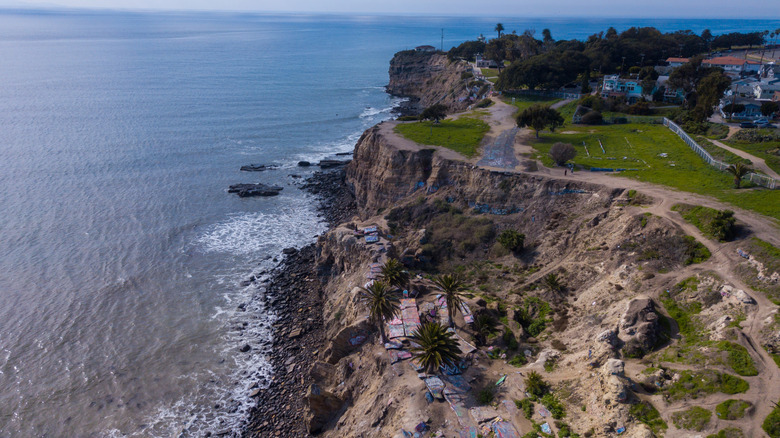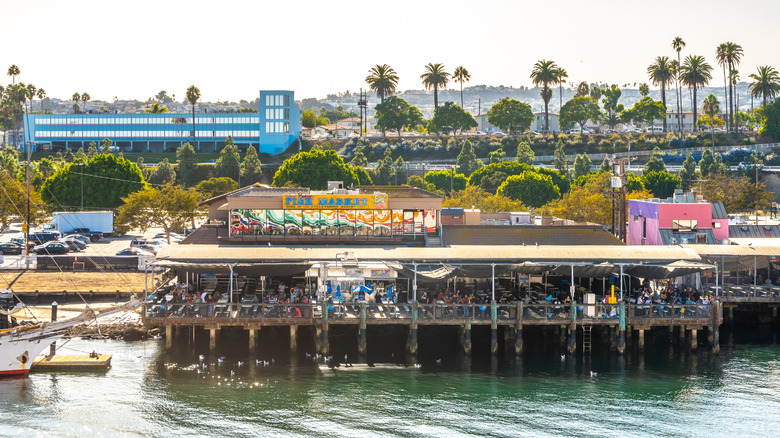The 'Atlantis Of California' Is An Iconic, Abandoned Neighborhood In The South
Southern California has many underrated sea cliffs and hiking trails up and down the coast, but one cliffside attraction that's popular with visitors is a hazardous former neighborhood in San Pedro that collapsed into the Pacific Ocean in the 1920s. Between Rancho Palos Verdes and Long Beach was once the thriving cliffside neighborhood of Point Fermin, which consisted of over 30 homes. The coastal area is now known as Sunken City and has been off-limits for decades, yet explorers still find a way into this ghost town.
The story of Sunken City started in 1929 when a water line was damaged under the Ocean View Inn hotel on January 2. This was followed by a broken gas line and landslides that caused 40-foot drops on the surface of the land. In April, heavy rainfall caused a crack in the terrain under 10 homes. Property owners complained about the cracks, but engineers at the time didn't have any cause for concern due to unchanged developments in land movements. A small earthquake in July tipped the neighborhood even more over the edge, and eventually, residents began to evacuate — many taking their homes with them. Almost all the wood-frame houses were relocated, while two drifted into their graveyards under the ocean.
Evidence shows that Point Fermin moved 11 inches per day, eventually sending 40,000 square feet of land into the Pacific. In 1935, the harbor district engineer asserted that the land had stopped moving, but in 1940, the Los Angeles City engineer feared another landslide was coming. That year, seven houses were occupied in the neighborhood, but the area has remained uninhabitable ever since. The once-residential community has now become known as the "Atlantis of California" for its homes, roads, sidewalks, commercial buildings, and rail tracks forever lost to the Pacific Ocean.
What you need to know about access to California's Sunken City
The impeccable views and historical fascination of San Pedro's abandoned Sunken City make it a sought-after destination, however, public access is forbidden. Sunken City Watch, a group dedicated to re-opening the site, claim the land has been safe for years and have urged the City of Los Angeles Department of Recreation and Parks to grant public access. But concerns over multiple deaths and injuries over the years, as well as eroding coastlines nearby, have been the argument for its continued closure. The 2011 landslides in nearby Paseo Del Mar and the ongoing sliding homes in Rancho Palos Verdes pose too much of a risk for Sunken City to open.
To deter visitors, trespassing laws are in place with fines of up to $1,000, but visitors still find a way to gain access to hike and take in the views, risking themselves on moving rocks, sloping lands, and steep cliffs. An iron fence was erected in 1987, however, visitors have been known to trespass via a hole under the fence. For decades, locals have been filing reports of antisocial behavior and vandalism at the site of this ghost town, with iconic graffiti and rock art now becoming a standout feature of California's Atlantis.
Sunken City isn't the only tourist attraction in California that's been cautioned as dangerous. The pretty but hazardous Mono Lake has been flagged for poor air quality and water, and Monastery Beach's dangerous rip currents have also been the subject of safety concerns for visitors in recent years — with many deaths occurring at the latter. Due to loose rocks, lack of cliffside safety measures, and strict trespassing laws, it is not recommended you visit San Pedro's Sunken City.
Things to do in San Pedro
While Sunken City may be San Pedro's most mysterious draw, the city is far from a one-hit wonder. San Pedro is home to a thriving waterfront, an artistic community, and one of the busiest ports in the world. Just a short walk from Sunken City is Point Fermin Park, a safer 37-acre clifftop featuring an amphitheater and playground that has long served as a gathering space for the community. The park offers views of the Pacific Ocean and even Catalina Island on a clear day.
Anchoring the park is the charming Point Fermin Lighthouse built in 1874. The Victorian tower was San Pedro Bay's first navigational light and played a vital role in directing ships safely. The lighthouse also holds historical importance as it served as a lookout during World War II. Visitors can tour the lighthouse for free on a first-come-first-served basis and explore its furnished interior while learning about past lighthouse keepers who once lived there. The Korean Friendship Bell is another striking cultural landmark in San Pedro that overlooks the Pacific Ocean. The gift, weighing over 17 tons and reaching 12 feet tall, was given to Los Angeles by South Korea in 1976 to celebrate the two alliances.
Visitors can also stroll along the bustling L.A. Waterfront of San Pedro, visit the Battleship U.S.S. Iowa Museum, or explore Cabrillo Marine Aquarium. The historic San Pedro Fish Market is a favorite local eatery for seafood lovers, and along 6th and 7th streets, you'll find an eclectic mix of boutiques, bars, galleries, and restaurants that reflect the neighborhood's unique character.


